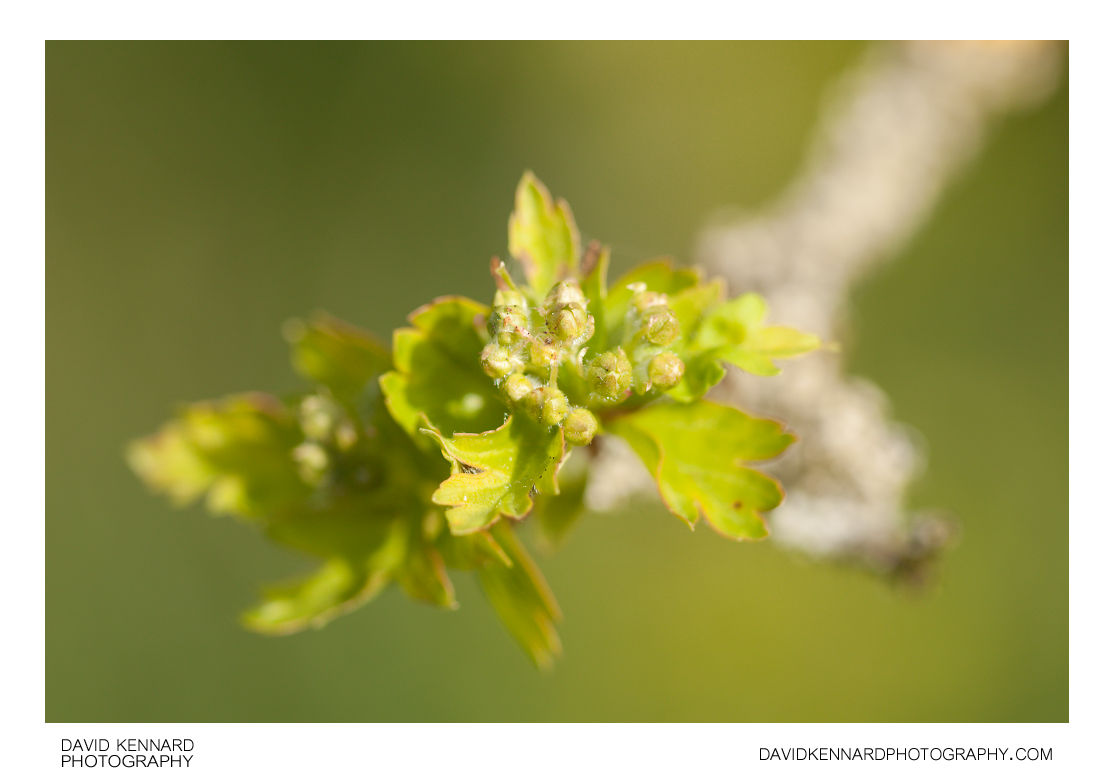Hawthorn new spring leaves and flower buds

Description
- Title:
- Hawthorn new spring leaves and flower buds
- Caption / Description:
-
New leaves and flower buds from an old Common Hawthorn tree whose branches are covered in Lichens.
Crataegus monogyna, known as Common Hawthorn, is a species of hawthorn native to Europe, northwest Africa and western Asia. Other common names include may, mayblossom, maythorn, quickthorn, whitethorn, motherdie, and haw. This species is one of several that have been referred to as Crataegus oxyacantha, a name that has been rejected by the botanical community as too ambiguous.
The Common Hawthorn is a broadly spreading shrub or small tree 5–14 m tall, with a dense crown. The bark is dull brown with vertical orange cracks. The younger stems bear sharp thorns, 1 to 1.5 cm long. The leaves are 2–4 cm long, obovate and deeply lobed, sometimes almost to the midrib, with the lobes spreading at a wide angle. The upper surface is dark green above and paler underneath.
The hermaphrodite flowers are produced in late spring (May to early June in its native area) in corymbs of 5-25 together; each flower is about 1 cm diameter, and has five white petals, numerous red stamens, and a single style; they are moderately fragrant. They are pollinated by midges and later in the year bear numerous haws.
Common Hawthorn is extensively planted as a hedge plant, especially for agricultural use. Its spines and close branching habit render it effectively stock and human proof with some basic maintenance. The traditional practice of hedge laying is most commonly practiced with this species. It is a good fire wood which burns with a good heat and little smoke.
Description taken from Wikipedia: http://en.wikipedia.org/wiki/Common_Hawthorn
- Tags / Keywords:
-
- Biota
- Life
- Vitae
- Eukaryota
- Green
- Plantae
- Plants
- Magnoliophyta
- Flowering Plants
- Angiosperms
- Magnoliopsida
- Dicotyledons
- Spring
- Rosales
- Rosaceae
- Roses
- Crataegus
- Hawthorns
- Crataegus monogyna
- Common Hawthorn
- Lichens
- Flower buds
- Young leaves
Admin
- Date Original Photo Taken:
- Original File Name:
- _MG_6854.CR2
- Event:
- Rating:
- ☆
- Date this image added/last updated on website:
- Original File Dimensions:
- 4272px x 2848px
- File Type:
- JPEG
- Color Mode:
- RGB
- Original Image Color Profile:
- Adobe RGB (1998)
Location
- Location Shown:
-
- Sublocation:
- City:
- East Farndon
- Province/State:
- Northamptonshire
- Country:
- United Kingdom
- World Region:
- Europe
- Location Created:
-
- Sublocation:
- City:
- East Farndon
- Province/State:
- Northamptonshire
- Country:
- United Kingdom
- World Region:
- Europe
- Geo-location:
- 52.4748972, -0.94932119996111 View on map
Rights
- Copyright Status:
- Copyrighted
- Licensing Status:
- Rights Managed
- Available for Editorial Use:
- Yes
- Available for Commercial Use:
- Yes
- Copyright Notice:
- © 2011 Dave Kennard
Camera Data
- Date Digital Resource was created:
- Shutter speed:
- 1⁄200 s
- Aperture:
- f/3.5
- Camera Model:
- Canon EOS 450D
- ISO:
- 100
- Exposure Compensation:
- 0
- Focal Length:
- 100mm
- Focal Length (35mm equiv.):
- Metering Mode:
- Center-weighted average
- Flash:
- Off, Did not fire
- Exposure Mode:
- Manual
- White Balance:
- Manual
- Light Source:
- Exposure Program:
- Manual
Additional shooting metadata
- Lens:
- Canon EF 100mm F2.8 Macro USM
- Filters used:
- Additional Optics used:
- Setup:
- Handheld
Post Processing
- Image Modified:
- Software used:
-
- Adobe Camera RAW
- Post Processing:
